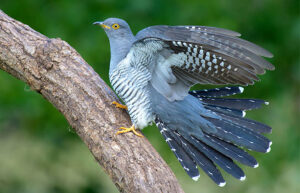
Cuculiade have a sad voice, Cuckoo is divided into 4 species: Cuckoo, black cuckoo, blue cuckoo (crowned cuckoo), and spotted cuckoo, in this article, from cotwer to temperament and what bird raises Cuckoo chicks
English name: Common Cuckoo
Arabic name: addictive laws
French name Coucou gris
Scientific name: Cuculus canorus
Cuckoo formation
They are mostly deciduous birds that live in the temperate and tropical polar regions of the world. With a relatively slender body and a long tail, the feathers of which gradually become shorter from the center to the side.
They have a thick beak and are slightly bent down. At their feet are two toes on the front and two toes on the back. They are monopods and lay eggs in the nests of other birds.
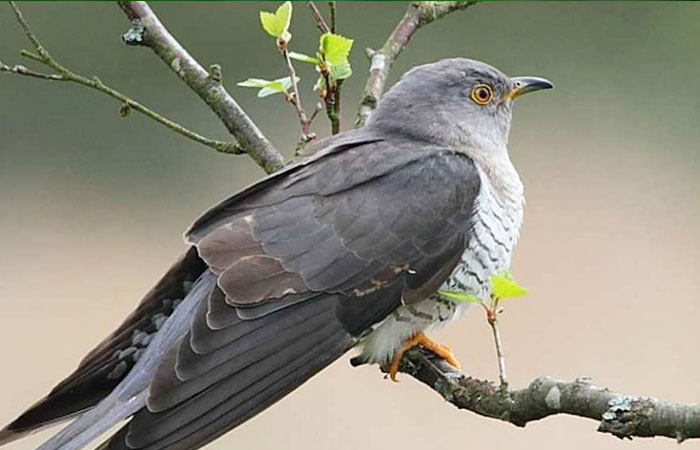
What do you know about the Cuckoo bird?
The way they reproduce and reproduce is very interesting and strange. The female cuckoo lays eggs in the nest of other birds during the spawning season, but not in the nest of every bird. The female usually lays her eggs in the Elika nest, which is a small and beautiful bird.
When a female lays her egg in the nest of one of these birds, she instinctively throws one or more eggs of the host bird out of the nest. The cuckoo lays only one egg in each nest. The host bird also sleeps on the eggs, turning them into chicks. If the Cuckoo chick is born earlier than the others, it instinctively throws the rest of the eggs out of the nest, even though it is not even ten hours old.
If it is born later, due to its large size and strength, it performs better when fed by the stepmother, so it becomes stronger and bigger by eating more food, and by pressing other weak chickens or on the spot. It kills or throws out of the nest, thus remaining alone in the nest and continuing to grow. Males and females are also shaped (except for the Asian cuttlefish, which are not considered Iranian birds).
other posts:
- Maintenance and breeding of canaries
- Make money from raising Cockatiel
- How to gray parrot talking?
- African gray parrot or Casco parrot
- Disadvantages of keeping dogs at home
How many categories are there in the Cuckoo family?
1 – black Cuckoo
The size of the black Cuckoo is 43 cm, similar to the Cuckoo, but with a thick beak, short wings, and a relatively long tail, it is not wrong for the Cuckoo. The male is a pale yellow with a bluish-yellow beak. The underside of the female is purulent brown, with pale white spots, a white throat and dark brown lines, and a dark brown oak rut.
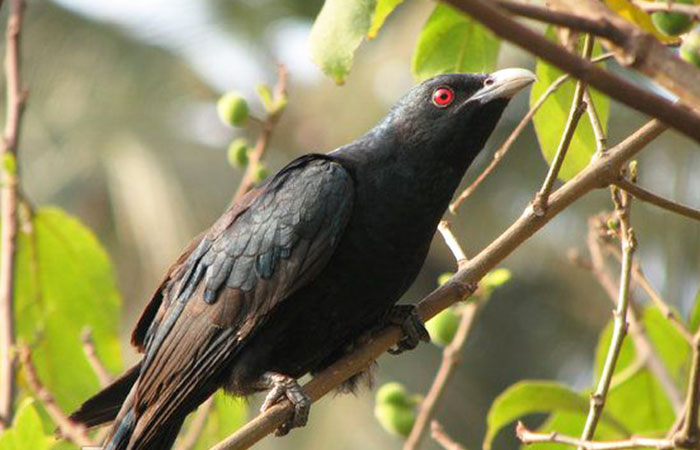
2 – Abloq Cuckoo(crowned Cuckoo)
The crowned cuckoo (crowned cuckoo) is 33 cm long and is the same size as a normal cuckoo. Distinct white spots on its wings, which are clearly visible in flight. It is easily recognized.
The underparts are white and the ends of the primary and secondary feathers of the wings are blackish brown. This bird has a rare black subspecies that has a white spot on its wings. In young birds, it has a smoky rut, a purulent white trunk, and a small crest.
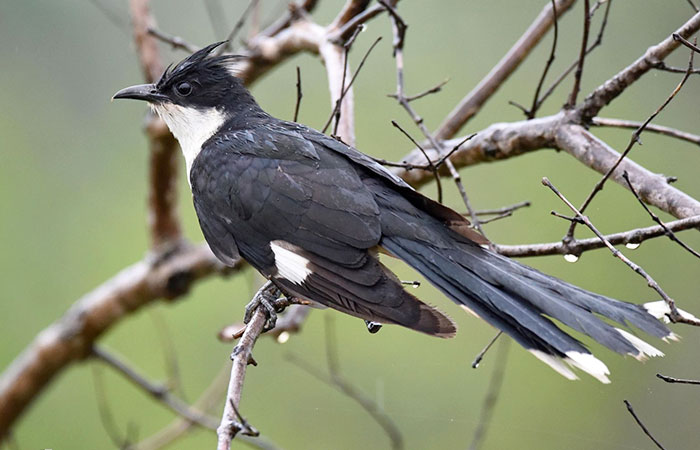
3 – Spotted Cuckoo
The large spotted Cuckoois 39 cm. Symptoms include a distinct crest, a long tail with white edges whose petioles gradually shorten from the middle to the side, and a brown dorsal surface full of white spots.
The surface of the abdomen and the sides of the head are creamy-white and the throat is yellow. Its eye-ring is light orange, the immature bird has an almost black head without a crest, and its first feathers are a thick oak. This bird is very noisy and showy in the breeding season and often sits on hedges. It looks like a “crow”. The flight is relatively powerful and direct. Like a crowned cookie, it is a social bird!

4 – Cuckoo
The size of the Cuckoo is about 32 cm. The body is slender, has a long tail, and relatively sharp wings, sometimes mistaken for a snail (with wide, round wings) in flight. It has a very distinct sound, its dorsal surface and throat are bluish-gray, and its ventral surface has a bold gray transverse path. The tail is long, gray, and round at the end. It has white spots on the tail and the end edge is also white.
Her legs are yellow. The immature bird has variable plumage and wings, its dorsal surface is either reddish-brown with a large transverse path (somewhat resembling a female crest) or grayish-brown with a slight transverse path. Both of these shapes have a white pea-like abdominal surface and a white spot on the back of the neck. Some female Cuckoos are sometimes brown in color, resembling reddish-brown juveniles. The bird is flying straight and flies before landing. This bird is a single-born off-season!
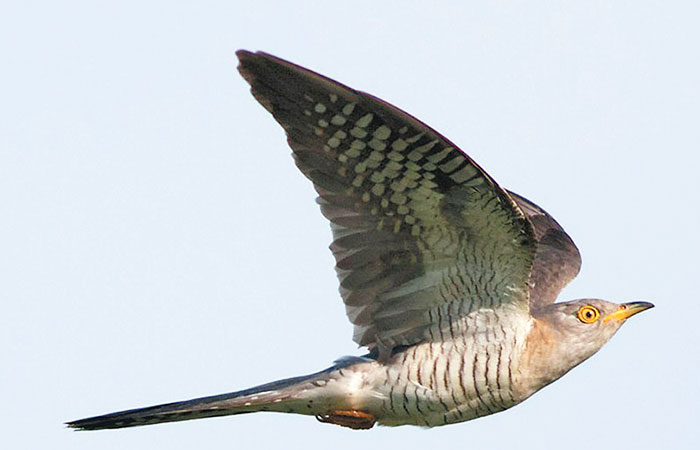
Cuckoo song:
Cuckoo’s name is derived from her voice. Cuckoo has a beautiful and mournful voice and is very specific.
Where does the Cuckoo bird live:
The cuckoo is a migratory bird that migrates to Europe and Asia in summer and to Africa in winter.
It is found on the edge of forests, in non-enclosed shrubs, as well as in treeless areas and sometimes in open highlands.
Cuckoo’s mood:
Usually, several males mate with one female. It lays eggs in other birds’ nests and often each bird becomes just a parasite of one species and lays only one egg in each nest. Usually, the area dominated by a female Cuckoo may have about 20 nests in which the Cuckoo lays eggs.
Cesk nests are typical wetlands of Cuckoo’s target nests. Interestingly, this bird spends a lot of time watching and selecting the nest of the Acrocephalidae of its choice to make sure that the bird lays its eggs, although finding this time by Cuckoo is still an environmental mystery.
At the right time, Cuckoo enters Cesk’s lagoon nest and skillfully lays one of its eggs, and replaces it with her own egg. The interesting thing is that this operation is performed by Cuckoo in 10 seconds!
After 14 days, the chicks hatch, which is 3 times the size of an adult wetland Acrocephalidae.
Wondering why Cesc’s pond feeds on Cuckoo chicks?
The loud, open-mouthed chick of Cuckoo in Cesque’s lagoon’s nest encourages it to bring her more food, and Cesque’s pond carries on the tradition of hospitality. After 20-21 days of partying, Cuckoo Chickens are ready to fly in the Cesk lagoon nest.
What does Cuckoo do?
Being a parent is hard. Less sleep, less free time, and all those hungry mouths that need to be fed. What should a busy mother do? You know you have to save your species, but who has the time? Interestingly, Cuckoo has reached the same answer as humans: outsourcing.
Cuckoo reproduction
When a female Cuckoo mates and is ready to lay eggs, instead of building a nest and preparing herself to take care of the cubs, she waits to find another female that has just laid eggs. He waits for the bird to come out of its nest to find food, and then lays its eggs in the same nest, repeating this in several other nests. When the deceived female bird returns, it nests in its nest and keeps the new eggs just like its eggs. Cuckoo eggs have a shorter incubation period than their host eggs, so foreign eggs hatch sooner, in which case the Cuckoo hen lays other eggs (or chicks if the timing is not correct). She pushes out and enjoys having a nest and a mother devoted to herself. Cuckoo chicks grow faster than their host species, so parents keep their bodies busy by constantly asking for food, eliminating competition.
But this would not be an interesting evolutionary contest if the host species accepted the problem easily and without objection. Birds bothered by Cuckoo eggs have tried several strategies to combat this problem. First of all, of course, this method is not very far-fetched, there is a strong hatred for them. The adult Cuckoos seen in the area of the hosts’ nests are quickly surrounded and driven away by a group of angry mothers. However, cuckoos have been able to take advantage of this by using a pair of male birds to annoy and deceive an angry bird group while the female bird lays its eggs in peace. Lays.
The second strategy for host birds is to learn to recognize alien eggs and prevent them from being thrown out of the nest. The Cuckoo has responded to this strategy in two ways. First, they have developed their eggs to be similar in color and size to the host’s eggs (and lay very dark eggs in nested areas that are not easily visible at all. Bird species with higher levels of rejection Hatching the alien’s eggs, they will eventually encounter a number of Cuckoo eggs that have become more and more similar to their’s eggs. It destroys the whole nest and destroys everything that is left inside in an act of maternal revenge.
The third strategy, designed by Superb Fairy Wren, is a little more creative. As soon as the host mother lays her eggs, she begins to sing to them with a definite pattern and rhythm. Now, the
The third strategy, designed by Superb Fairy Wren, is a little more creative. As soon as the host mother lays her eggs, she begins to sing to them with a definite pattern and rhythm. Now, the Cuckooeggs hatch at about the same time as their own eggs, but they are laid there a few days later than their own eggs. This means that his own chicks have learned to sing before birth, longer than Cuckoo’s chicks. When the eggs hatch, only their own chicks can repeat their songs correctly. So a chicken that can not sing will not receive food. And even if the parasite chick can throw her chicks out of the nest before she dies of starvation, the mother will not hear the right answer to her song at all and realizes that she has to leave the nest altogether, so it is in her best interest. This is how it is.
‘s eggs hatch at about the same time as their own eggs, but they are laid there a few days later than their own eggs. This means that his own chicks have learned to sing before birth, longer than Cuckoo’s chicks. When the eggs hatch, only their own chicks can repeat their songs correctly. So a chicken that can not sing will not receive food. And even if the parasite chick can throw her chicks out of the nest before she dies of starvation, the mother will not hear the right answer to her song at all and realizes that she has to leave the nest altogether, so it is in her best interest. This is how it is.
There is at least one known case of a former host species that has completely eliminated this parasitic barrier. The red-backed eye stone is very skilled at detecting Cuckoo’s eggs, except that it is clearly killer aggressive towards Cuckoo (and many other things). very fast. So fast that researchers believe that Cuckoo simply did not have the opportunity to adapt. In laboratory tests, eye stones were identified and rejected in 93.3% of all Cuckoo eggs. This ability to identify patterns is fantastic for this bird. Although the parasitic relationship between Cuckoo and eye stones has been known for a long time, it has not been seen in nature in the last 30-40 years.
Interesting facts about Cuckoo
Even Cuckoo, which is not normally parasitic, sometimes lay their eggs in the nests of individuals of their own or other species, but still help feed the chicks.
The eggshells of parasitic Cuckoo are unusually thick, preventing them from breaking when the mother throws the eggs into the host nest from above.
- Striped cuckoos are not satisfied with throwing out their bodies siblings and pecking them to death.
Some birds encounter these killer Cuckoo by building nests with steep slopes, making it difficult to remove the chicks from the nest, and the mother raises all the chicks.
An interesting legend of the bird Cuckoo
In Europe, hearing a Cuckoo’s voice is known as the messenger of spring.
Almost every year on April 14, English newspapers use the proverb in which the Cuckoo is known as the messenger of spring.
In Russia, many people believe that the sound of a Cuckoo means your longevity, which means that if you hear the sound of a Cuckoo and the Cuckoo calls Cuckoo many times, you will live the same number of years.
In Austria, there is a similar belief that people consider the sound of the Cuckoo as the number of days of the wedding ceremony, and also that the number of sounds of the Cuckoo means the number of years that two couples have lived together.
In France and Romania, hearing the number of Cuckoo means how much money you earn, so the more you hear Cuckoo, the more money you start the year.
Dear user, if you have any questions about “Cuckoo Bird”. Share with us and other users in the comments section at the bottom of this page. And stay tuned to cotwer Magazine to learn about animal care and diseases.
read other articles:
Comments